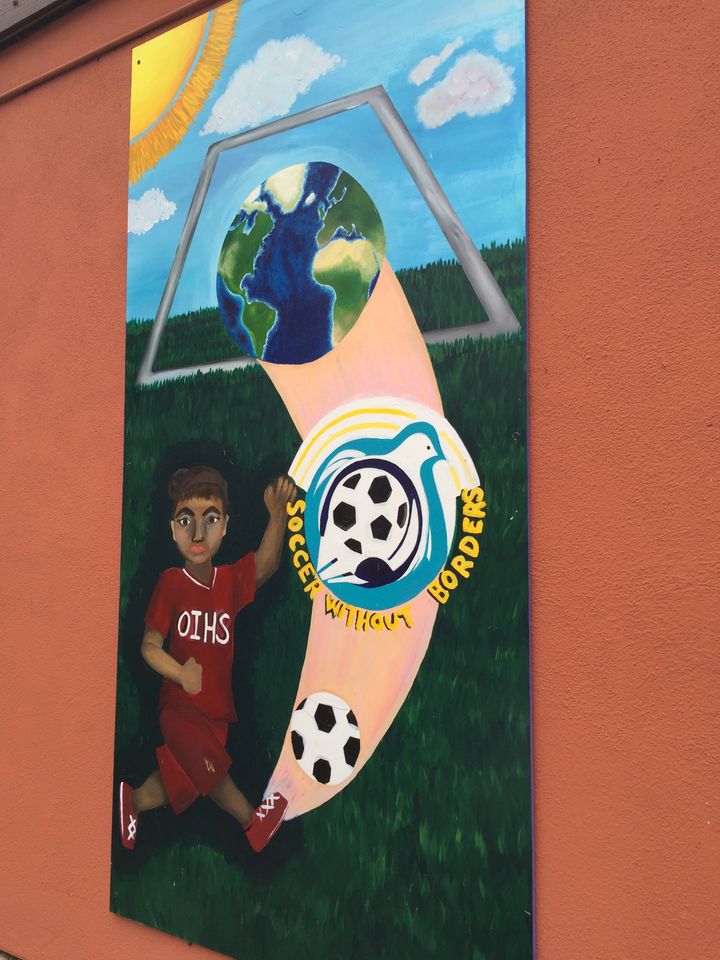
Mural outside of Oakland International High School where Soccer Without Borders is a 21st Century After-School Program
As an undergraduate at an Ivy League school, most of my days were spent moving between places with names like Baker Tower, Wheelock Hall, and the Rockefeller Center. Walking across the campus, I hardly considered that the names of these buildings represented tens of millions of dollars in charitable gifts. Never once was I made to feel as though I was accepting a handout by walking their halls. In fact, it wasn’t until recently that I started to fully grasp the disproportionate charity that I - and everyone who attended a private school at the college, high school, or primary school level - benefitted from.
Let’s take a look at the math: On the Dartmouth College Fund website it says that the College now spends $128,204 per student each year, while collecting $63,748 in tuition, room, and board from full-pay students. The gap is in large part funded by endowment income and charitable gifts, both of which are tax-free. That’s nearly $65,000 per year of untaxed revenue funding full-pay students, and an average of $43,648 more for those who qualify for financial aid (admittedly a mix of grants and loans). According to Fox Business, from 2010–2015 these eight schools cost taxpayers $6.93 billion dollars each year, which amounts to $120,000 per Ivy League student in government aid.
As Co-Founder & Executive Director of the 501(c)(3) non-profit Soccer Without Borders, I am responsible to ensure that charitable dollars invested in our mission are maximized to support under-served youth to reach their full potential. The youth we serve are some of the most vulnerable in the United States, nearly all are from low-income families and English Language Learners, a statistically risky combination. We leverage a combination of individual, foundation, corporate, and government funding to provide year-round after-school and summer programs that have supported these young people to graduate high school at a rate of 95%, more than 30% higher than their peer group nationwide. Our work is made possible by programs like 21st Century Community Learning Centers from the Dept. of Education and Americorps from the Corporation for National Community Service, both of which were recommended for elimination as a part of slashed funding to domestic programs. Together, initiatives like these serve millions of low-income children and families each year through organizations like Soccer Without Borders. Their elimination would mark a collective savings of 1.9 billion dollars annually- 27% of the amount spent annually underwriting Ivy League students.
I would like to set aside, for today, the debate about whether elite institutions with large endowments should be taxed, the value they provide to society through research and teaching, and whether the higher education bubble is inevitably going to burst. Dartmouth maintains its tax-free status by fulfilling its mission to “educate the most promising students,” and my purpose here is not to evaluate our public return on investment for that mission. My question is this: Why are gifts to Dartmouth and other educational institutions viewed as an investment in promising students, but charitable gifts or government investment in other youth programs are “handouts” that “create dependency?”
The answer, I believe, lies in our concept and teaching of empathy.
My understanding of empathy- on a societal level- was not cultivated at Dartmouth, but rather on a soccer field in Nicaragua. Two years ago, I wrote a piece about a woman named Cora, a talented young athlete for whom our Soccer Without Borders program in Nicaragua was simply not enough. Recently, I passed by Cora’s house in Granada, only to find her son being cared for by his grandmother. Cora is in jail. I think back to that moment on that dirt field when I met her, and I’m haunted by the very same thought I had that day: she is just like me. Born into a different country, under different family circumstances, a soccer-loving tomboy with a talent for juggling, headers, and finding the goal could both describe her, an orphaned girl in Nicaragua, or me, the daughter of a professor in Massachusetts. I imagine how different her life could have been if society invested $120,000 in her future.
Empathy is not just the ability to walk a mile in another’s shoes, or show compassion to those less fortunate, but to actually imagine life from their circumstance. It is from this mindset that solutions are born. Lila Watson once said, “If you’ve come to help me you’re wasting your time. If you’ve come because your liberation is bound with mine, then let us work together.” Empathy helps us eliminate the rhetoric of “us helping them” and get to the “we” of our communities, country, and humanity. Empathy gets us in the arena, volunteering, raising money, and staying engaged over time. It compels us to do the work of building and sustaining fairer systems in which all persons have the opportunity to thrive.
True empathy would drive us to see the promise in every student- regardless of circumstance- and invest more equitably in their potential. Resource allocations must work to level the playing field, and we need to acknowledge that even our charitable resources often disproportionately benefit the upper classes. Lila Watson’s words have never rung truer: our liberation as a humanity, as a nation, as cities, is bound together with everyone in it. Programs born out of empathy and a desire to level the playing field for the next generation are not helping “them.” They are lifting us all.
